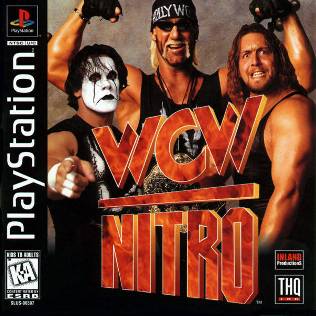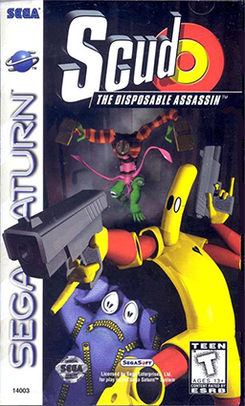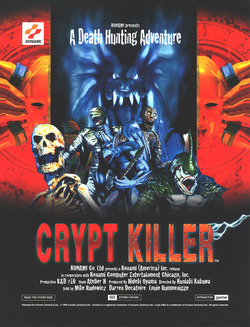
Time Crisis is a light gun shooter arcade game, developed and released by Namco in 1995, and the first title to be released in the series of the same name. The game differentiated itself from other light gun shooters of the time by incorporating a pedal that controls when the player character takes cover to reload and avoid enemy fire. Players have a limited amount of time to clear each section by defeating enemies. The game's story focuses on Richard Miller, a secret agent, who is sent to rescue a kidnapped woman from a ruthless tyrant seeking to reclaim control of their former country from a new regime.

Einhänder is a scrolling shooter developed by Square for the PlayStation console. It was released in Japan on November 20, 1997 and in North America on May 5, 1998. It was also re-released for the Japanese PlayStation Network on June 25, 2008. The name Einhänder is German and denotes a type of sword that is wielded with one hand, here used to refer to the single manipulator arm possessed by the player's spacecraft.

War Gods is a fighting video game originally released to arcades by Midway Games in 1996. Ports for the Nintendo 64, PlayStation and Windows were released in 1997. In the game, players control one of ten fighters who have been given great power by a mysterious ore that crashed-landed on Earth from outer space. The object of the game is to defeat all the other fighters to become the most powerful warrior on the planet.
Point Blank, known as Gun Bullet, or Gunvari in Japan, is a series of light gun shooter games developed by Namco for the arcade, PlayStation and Nintendo DS; the trilogy was first released in arcade in 1994 and was later ported onto the PlayStation. Point Blank DS was released in 2006 for the Nintendo DS featuring 40 challenges from the original series.

Madden NFL 98 is a 1997 football video game. It was the last edition of the Madden series to be released for the Super NES, Genesis and Sega Saturn platforms, as well as the last Madden game to utilize 2D sprites for the players and referee, on 3D playing fields.

Guardian Heroes is a 2D side-scrolling beat 'em up video game in the vein of Final Fight or Golden Axe, but with RPG elements. The development team called it a "fighting RPG". Guardian Heroes was developed by Treasure and released in 1996 for the Sega Saturn video game console. A sequel was released in 2004 for the Game Boy Advance entitled Advance Guardian Heroes.

Batman Forever: The Arcade Game is a beat 'em up video game based on the movie Batman Forever. The subtitle is used to differentiate it from Batman Forever, another beat 'em up published by Acclaim at around the same time. One or two players, playing as Batman and Robin, fight Two-Face, the Riddler, and numerous henchmen.

WCW Nitro is a professional wrestling video game based on the television show WCW Monday Nitro. Released by THQ for the PlayStation game console in 1998, the game featured a large roster of playable WCW wrestlers as well as full motion video clips of the television show. The game was followed by WCW/nWo Thunder, which was based on Nitro's Thursday night counterpart. Ports for Nintendo 64 and Microsoft Windows were released later in 1998 and 1999 with the updated roster featured in Thunder.

X2 is an arcade-style side-scrolling shoot 'em up released during the Team17-Ocean collaboration era of video games that created the Worms series. It is the sequel to the Amiga shooter Project-X. Unlike its predecessor, this game was a console exclusive. Acclaim Entertainment was slated to publish the game in North America, but it was never released in that region. A Sega Saturn version of the game was scrapped during development, at least in part due to Acclaim withdrawing support for the Saturn.

Black Dawn is a helicopter-combat simulation, published by Virgin Interactive Entertainment. It was released on the Sony PlayStation and the Sega Saturn in 1996.

Batman Forever is a beat 'em up video game based on the film of the same name. Though released by the same publisher at roughly the same time, it is an entirely different game from Batman Forever: The Arcade Game. The game was followed by Batman & Robin in 1998.

Scud: The Disposable Assassin is a Sega Saturn video game based on the comic book series of the same name. It was released on March 20, 1997 in North America only, though it is region-free. It is unusual in that it can be played either as a run and gun game, or with a light gun. The main characters and plotline are mostly the same from the comic series, and Scud creator Rob Schrab said that he felt it did justice to his characters.

Spider: The Video Game, is a 2.5D platform game developed by Boss Game Studios and published by BMG Interactive for the PlayStation. It was the only release published under the BMG Interactive label in the U.S. The player takes the role of a cybernetic spider, within which the mind of its creator, Dr. Michael Kelly, has been implanted.

NBA Hangtime is a 1996 basketball arcade game developed and released by Midway. Home versions were released for the Nintendo 64, PlayStation, Super NES, Sega Genesis, and Microsoft Windows.

Alien Trilogy is a first-person shooter video game developed by Probe Entertainment and published by Acclaim Entertainment in 1996 for the PlayStation, Sega Saturn, and MS-DOS platforms. The game is based on the first three movies in the Alien film series. One of the first games developed by Probe following their acquisition by Acclaim, it debuted Acclaim's much-hyped motion capture technology. The game was well-received by critics, who praised its recreation of the films' atmosphere and its gameplay depth compared to other first-person shooters, and was a commercial success.

Arcade's Greatest Hits: The Atari Collection 1 is a compilation of Atari arcade games for the Sega Saturn, PlayStation, and Super Nintendo Entertainment System. It is a successor volume to Williams Arcade's Greatest Hits. Most of these games fall into the action game category. The Saturn and PlayStation versions of the game include an FMV documentary on the "Golden Age of Atari", featuring video interviews with the programmers behind the six games in the compilation. The later Super NES version was announced by Midway as their final release for any "16-bit" console.

Crypt Killer is a 1995 arcade video game produced by Konami. It was also released in 1997 for the Sega Saturn and Sony PlayStation home consoles, and in Japan for Microsoft Windows. The Saturn version makes use of the Saturn's various light guns, while the PlayStation version is compatible with the Naki Lunar Gun and the Konami Justifier. The game's scenery and characters are all 3D polygon models, while most of the enemies and their projectiles are 2D sprites.

Supreme Warrior is a full-motion video (FMV) beat 'em up game developed by Digital Pictures. It was released for the 3DO Interactive Multiplayer and Sega CD in November 1994 in North America and in early 1995 in Europe, with subsequent releases in 1995 for the 32X, Macintosh, and Windows. The game is themed as a kung fu film where the player has to fight off opponents to protect half of a magical mask.
Sky Target is a 1995 arcade game by Sega. A rail shooter featuring a number of planes including the default F-14D Super Tomcat, it is best remembered for its semi-official connection to Sega's earlier hit After Burner. Although never billed as a sequel, its overt similarities to the 1987 classic were nonetheless referenced in official promotional materials and recognized by the media. Plus, it features a revised version of the "After Burner" music theme within its soundtrack.

Three Dirty Dwarves is a 1996 beat 'em up video game developed by Appaloosa Interactive and published by Sega for their Sega Saturn console. It was later ported to PC.

















